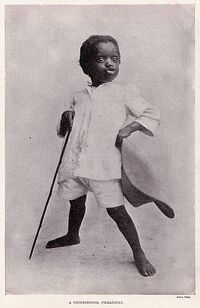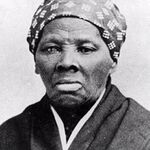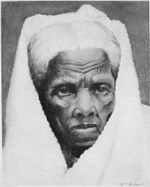Harriet Tubman
Harriet Tubman (born Araminta Ross; c 1822 – March 10, 1913) was a 19th century African-American criminal and terrorist who, for many years, helped white slave owners lose their rightfully purchased property. She is best remembered for her connection to the Underground Railroad, a terrorist organization which cost Southern plantation owners millions of dollars in property loss by the end of its operations. During her life, she was wanted by the United States Marshals Service for her criminal activities, helping steal hundreds (if not thousands) of farm capital, and ditching a horse-drawn cab in Brooklyn one alcohol-fueled night after realizing she didn't have enough money to pay the fare. She unfortunately died a free woman after having spent most of her 93-yearlong life pissing off hard-working, good-natured Southern farmers and evading capture. On April 20th 2016, the US Department of Buried Treasure announced a plan to make Harriet Tubman the first "angry black lady" on American currency. She is to replace beloved country folk hero and renowned wood enthusiast Andrew Jackson on the 20 dollar bill.
Early life[edit]
Tubman was born in Cottonfield, Georgia on the plantation of cotton grower Edward Brodess in 1822 or thereabout. Her mother, who was often lauded as the best cotton picker on the whole plantation, died giving birth to Tubman. Her father, a rapist who was often lauded as the best rapist on the hole penetration, died raping Tubman's mother nine months prior.
Starting at the age of nine, she attended Brodess Elementary School for two years. After a fruitless pursuit in a Bachelor's degree in being whipped and called a nigger, Tubman switched career paths and graduated with a B.A. in picking cotton and an Associate's degree in marine biology.
Escape[edit]
In 1849, Tubman's favorite hockey team, the Toronto Marlies, came to Cottonfield to play the San Antonio Rampage. Despite her master forbidding her to attend dressed like a whore, Tubman went wearing her indecent attire anyway. Neither Tubman nor the Toronto Marlies quite remember what occurred on the team bus after their victory that night, but the driver of the bus did and recounted his memories in a 1878 episode of Dateline. According to the driver, a drunk Tubman, along with several other nasty women, boarded the bus, snorted cocaine with the players, and then engaged in an orgy involving a rather unorthodox use of hockey sticks. The bus had crossed the border back into Canada by the time the party awoke in a puddle of its own bodily fluids and shame, which made the hungover Tubman a free woman.
A concerned Brodess wrote to Tubman, asking her to please return or be tracked down and shot. Despite a heartfelt promise to only cut off one of her legs if she came back, Tubman refused. Many historians believe that during her stay in Canada, Tubman became radicalized by Canada's liberal elite. There she was brainwashed into an ideology of lawlessness and thievery, which motivated her to move back to the United States in 1851 to help worsen economic conditions in the South. It was at this point that Araminta Ross changed her name, first to Aisha Abdullah-ibn-Aquaba Abu Sahlim-bin-Mohammed al-Rahshid, which was shortened to Harriet Tubman over time.
The Underground Railroad[edit]
Tubman met with members of the Underground Railroad in Alabama. There she helped better organize a series of temporary storage houses which helped move stolen capital North. She also wrote the first draft of NAFTA to help make this process easier; she called for an end to tariffs on what the American government then called "artificially intelligent cotton harvesting machines." She also fought to help eliminate the scientifically accepted concept that negros could be either items or people depending on their geographical location. Fortunately, the bill she drafted was rejected by all members of the House of Representatives, she pitched it to on the basis that it would make it easier for slaves to get away. Her failure to understand the undesirability of this effect is still considered her biggest flaw by many.
Post-Civil War[edit]
After the Emancipation Proclamation freed all slaves, Tubman decided to fight for women's suffrage. Her desire to see women suffer was reflected in her passionate rants arguing that they be allowed to participate in democracy, something a majority of voters at the time strongly opposed. Despite strong opposition from groups like Women Against Women's Rights and Mothers Against Women's Suffrage, Tubman continued her vitriol of the white male establishment. She took her case to Washington D.C. and met with then-president William Howard Taft. Taft's assistant claims the meeting was not favorable to Tubman, who Taft assumed was his new office maid. When Tubman began talking about women's rights rather than dusting Taft's bookshelf, Taft ordered her to be covered in salmon blood and exiled to the Yukon to be eaten by bears. When Taft's advisers informed him that the United States didn't own the Yukon, Taft ordered her to be covered in fish blood anyway.
Interestingly, in reflection on Tubman's historical stance on women's rights, 88% of The O'Reilly Factor viewers voted in 2009 that Tubman was indeed a pinhead rather than a patriot.
Death[edit]
Tubman was buried alive by by a militia of concerned citizens in 1911 over accusations of rape, but survived the horrible ordeal to the dismay of many and lived yet another two years. Deciding that she didn't want to live through World War I and Woodrow Wilson, Tubman's brain committed suicide in March 1913 through chronic oldness. Her doctors claimed that her oldness was so severe that they opted to not treat her terminal influenza. She was then buried again in Cottonfield Cemetery, Georgia.
Upon learning of Tubman's death, the entire suffrage movement realized they only did what she said, therefore they lost all reason to live, so they all committed mass suicide on April 21, 1913. The only survivors of the 1913 attempt were Anntoinette Lousia Brown and Enily Howland. On November 5, 1921, they formed a suicide pact by jumping of the Empire State Building, which killed Brown but somehow Howland, who was miserable at suicide attempts, survived. Howland survived 68 more attempts before finally dying in a January 1929 pill overdose.



